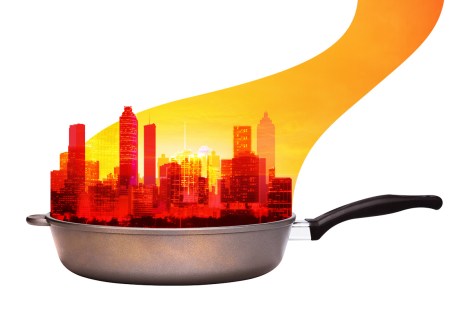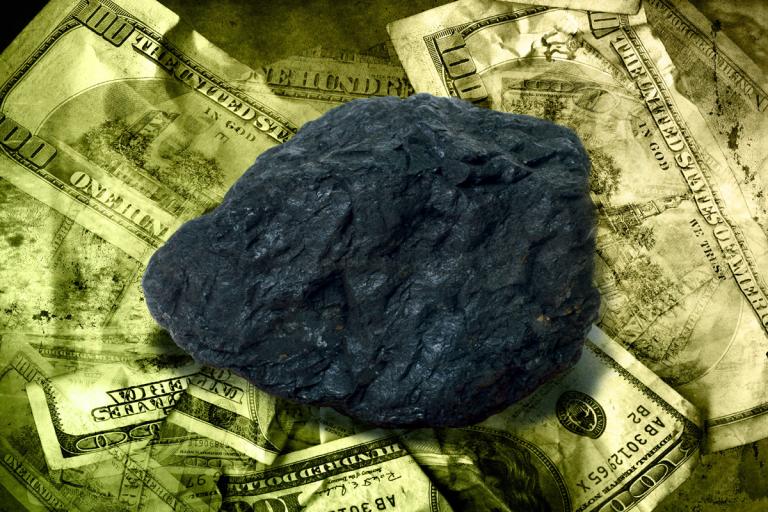
Shutterstock
There are hot islands, there are really hot islands, and then there are urban heat islands [PDF] — cities that are hotter, often considerably, than their more rural surrounds. Sound a little strange? Well, you can tell your foil hat-wearing, climate-denying friends it’s nothing new, having been documented as far back as 1810. Simply put, cutting down all the trees, paving over every inch of earth, burying streams in storm drains, and building enormous structures warms things up a bit.
Some may like it hot, but the good folks of Louisville, Ky., will tell you that it’s not always a good thing. Cursed with often stagnant wind conditions, a dense urban center, and fewer trees than Paul Bunyan’s backyard, Louisville has seen temperatures rise 1.67 degrees F every decade since 1961. If the pattern holds, by the year 2112, we’ll be able to cook lentils in the average tumbler of bourbon.
And what’s worse than one urban heat island? (You’re going to kick yourself when you see the answer.) Two urban heat islands! And that’s just what Baltimore, Md., the Paris of the mid-Atlantic, is facing. Baltimore already suffers from serious second-city syndrome, but being downwind from Washington, D.C., causes climate problems as well. D.C.’s considerable heat island slows down the wind that would otherwise cool off Charm City. Baltimore’s urban heat island is so intense, the growing season has been altered, spring is coming two weeks earlier, and the crabs arrive pre-steamed.
There are a lot of reasons cities heat up. There’s the obvious: all those factories belching smoke (well, not so much in the states, but it might be an issue in Jiaxing), cars shooting heat out of their tailpipes, and don’t even get me started on the BTUs generated by all the hot deals down at the mall. But that’s just the beginning. Those factories require huge buildings, cars require roads, and those malls mean massive parking lots and great expanses of hard-top roof. Roofs and roads are often dark, and would you wear a black suit to, say, a picnic in an active volcano? Of course not, it’s a terrible, terrible summer color. Also, black absorbs heat. Dark roofs average 43 degrees F hotter than similar white ones, according to NASA.
Those hard surfaces are also impervious to water, meaning that rain runs off of them, heating local waterways [PDF] and denying cities the cooling moisture unpaved earth provides. Then there are the buildings themselves, which block breezes and radiate heat across narrow streets, like the walls of a desert canyon [PDF], further warming the air. Hotter temperatures also mean that people in those buildings use their air conditioners more — and air conditioners give off their own hot exhausts. A/C use also means more power and more hot exhaust from power plants. It’s like a snake eating its own tail, except the snake is also on fire.
And we haven’t even gotten to what is likely the biggest contributor to urban heat islands: the fact that we’ve mowed down so many trees to put all this other stuff up. A good healthy tree canopy has a lot of benefits for a city, and cooling things off may be chief amongst them. Tall trees provide shade. Without them, we might all have to wear these (the umbrella hat, not the grumpy mustachioed man). Trees also retain moisture, which a city needs to stay cool. And by taking water absorbed in their roots and releasing it back through the leaves (in a process called evapotranspiration), trees act as time-released cooling capsules. Having a tree is like sitting in the splash zone at Seaworld without all the guilt of enslaving an orca. Cut it down, and things get uncomfortable in a hurry.
So it gets hotter — big deal, right? I’ll just drink more refreshing summer cocktails. Unfortunately, like so many of life’s enormous problems, the urban heat island effect falls far harder on the poor. Poor neighborhoods often have fewer trees and way more heat, and those rising temperatures are a much bigger deal when you can’t afford air conditioning and have no way to escape the urban inferno. Consider this: 285 people were killed by Superstorm Sandy. During the three days of Chicago’s heat wave of 1995, over 700 people died. A study in the New England Journal of Medicine cited lack of transportation and working air conditioning as major risk factors.
There are, fortunately, lots of ways to mitigate the urban heat island effect. The most obvious would be to build a sun-blocking machine, hire dastardly Bat-Villain Mr. Freeze, or simply assassinate the Heat Miser. But all of these solutions have their problems. (A sun-blocking machine is prohibitively expensive, the Heat Miser is completely fictitious, and Mr. Freeze brings with him his own problems, including murder, mayhem, and most horribly, puns.)
Thankfully, there are also some real-world fixes:
- “Cool pavement” technology uses cool colors and solar-reflective coatings, can be applied to existing surfaces, and reflects as much as 10 times more solar radiation than traditional blacktop.
- Grass-pavers form a concrete web, allowing grass to grow through parking lots and driveways, are also more reflective than blacktop, and also retain storm water, which helps cool local waterways.
- Reflective and green roofs offer similar benefits while also keeping buildings cooler and reducing the need for air conditioning — kind of like a snake eating its own tail, but it’s like, an ice snake or something.
- Most important is cultivating a healthy urban tree canopy. Trees can lower direct temperatures as much as 45 degrees F [PDF], reducing A/C demand while cleaning up air pollution, which also exacerbates warming, and fighting stormwater runoff. Plus, they make this guy a lot happier.
So get thee to a tree planting! Do it for your own sake. Do it for the planet. Urban heat islands contribute to climate change — albeit in a small way. You see, when we’re cooking on the sidewalk, we’re experiencing just one slice of the heat island — what is known as a “surface” heat island, the intense ground-level heat of a city. While a surface heat island is most intense in the late afternoon and less noticeable at night, as the city surface cools, its heat dissipates into the night air, creating an “atmospheric” heat island. While not as intense as the surface version, the atmospheric heat island for a city of a million people can raise the temperature at the tree canopy level 5.4 degrees F. The effect can reach over a mile straight up and change the climate for miles around.
Of course, there are upsides to all this heat. The lemonade stand industry will see booming business, we’ll no longer need skillets, and if our pet skinks escape, no worries! They’ll thrive in their new super-heated home.




